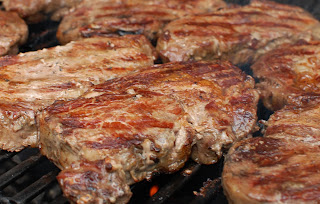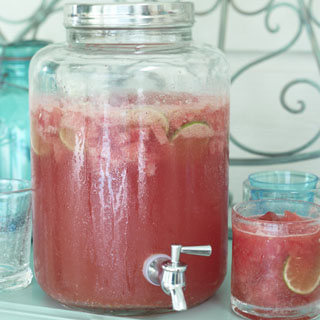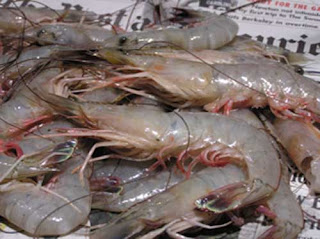A well-made fire is the essential first step in the technique of grilling. The right fire makes barbecuing smooth and simple. The temperature of the fire needed depends on the type of meat you are going to cook. For cuts of meat such as steaks, burgers, and kabobs which you intend to cook rapidly, use a relatively hot fire. A moderate fire is fine for roasts and larger pieces of meat. For slower cooking cuts of meat such as pork chops and spareribs, use a slow fire.
Charcoal comes in two forms: lump charcoal and briquets. Lump charcoal is in odd-sized pieces just as they come from the charcoal kiln. It is less uniform in burning quality and more difficult to handle. Briquets are ground, lump charcoal pressed into uniform blocks. They are easier to use, burn evenly, and produce a more uniform heat. They are easier to control and burn longer than lump charcoal.
Pile the charcoal in a pyramid on the firebox of the grill. You don't need much charcoal. Beginner chefs are often too ambitious, build too big a fire. After you've built several barbecue fires, you'll be able to gauge the amount easily. Add liquid lighter to charcoal; wait a minute, then light. Do not use gasoline or kerosene. Let charcoal burn for 15 to 20 minutes until the briquets are about two-thirds covered with gray-ash. Spread the briquets evenly throughout the grill. The bed of coals should be shallow (easy to control) and just a little larger than the area of food you are cooking.
The fastest way to get a bed of cooking coals (about 15 minutes) is with an electric fire starter. Most other methods of fire starting take approximately 45 minutes. A chimney is another secret for fast take off. Make your own from a tall juice can or a 2-pound coffee can. Remove ends from can. Using tin snips, cut out triangles or circles around bottom, 1 inch apart, to allow draft. Or punch triangular holes with a church-key bottle opener and bend down for legs. (While the bottle opener is out, be sure to use it to open an icy cold beverage for Dad while he labors over the hot flames.)

Place a wad of newspaper in the base of the chimney, add 6 to 8 charcoal briquets, and then light the paper from the bottom of the chimney. When the briquets are burning, add more to the top. Allow to burn about 15 minutes, and then lift off chimney (with tongs!) and rake coals where you want them.
Don't start to cook until the fire dies down to glowing coals. Coals are ready for cooking when they look ash-gray by day, and have a red glow after dark. No flames! Don't start cooking too soon. When coals are hot, tap off the gray ash with fire tongs; ashes on the briquets insulate and retard the heat.
An easy way to tell the heat of the fire is to hold your hand over the coals at the height the food will be for cooking. Begin counting "one thousand one, one thousand two", and so on. The number of seconds you can comfortably hold your hand over the fire will tell you how hot the fire is. If you can count to "one thousand two," you have a relatively hot fire; "one thousand three" or "one thousand four" is about a moderate fire, and "one thousand five" or "one thousand six" is a slow fire.
If you are cooking a large piece of meat that requires a long cooking time, plan to replenish the coals from time to time. Add a little extra charcoal around the edges after your fire is ready for cooking. Don't top your cooking fire with cold coals; this will lower the temperature more than you think. To increase heat, add warm coals from the reserve around the fire's edge.
To slow down the fire, move hot coals out to make a larger oval; to increase heat, move hot coals in to make narrower oval. This technique helps maintain the even cooking. Fire is ready only when flames die down. In broad daylight, the coals will look ash-gray and after dark, they'll have a red glow (they burn from outside in).
If drippings do flare up during cooking, sprinkle the fire lightly with water to quench the blaze. Keep handy a clothes sprinkler filled with water close by. Use only enough water to do the trick; don't soak the coals. It will take some time for very wet coals to dry out and begin to burn again. It will also reduce the intensity of the heat of the fire.

Orders for "rare" go on the grill last. When you see little bubbles on top surface of the steaks, they are ready to turn (heat forces the juices to the uncooked surface). Flip steaks with tongs and a spatula; piercing with a fork wastes good meat juices. Cook the second side a few minutes less than the first since the second side has a head start on heating. Turn only once. For 1-inch steaks cooked medium-rare, allow 13 to 15 minutes total grilling time. It is always a good idea to use a meat thermometer when grilling. Insert thermometer so tip is in center of meat. Tip must not touch bone, fat, or the metal spit.
For charred crusty coat, try this: Sear one side by lowering grill top close to coals for 2 to 3 minutes, then raise grill to finish same side. Turn steak, and sear second side; again raise the grill and complete the cooking.
Wait until you turn the meat to salt it. Salt and pepper the browned side and then season the other side as you take it off the grill. If you salt uncooked meat, the juices will be drawn out and you'll lose good flavor. It is also important to let any grilled meat rest for at least 5 minutes before serving to allow the juices to retreat, otherwise all the flavor drains out of the meat when it is cut.
 While mild dehydration is not a serious health issue, it can make your daily life a little bit harder. One of the first signs of dehydration is thirst. Unfortunately, your body`s signals for thirst are so similar to its signals for hunger that some people can`t tell the difference. If you are trying to drop a few pounds and they just won`t budge, try drinking at least eight tall glasses of water every day. This will not only quiet false hunger pangs, but staying hydrated also helps to keep your metabolism working properly so that you burn calories more efficiently.
While mild dehydration is not a serious health issue, it can make your daily life a little bit harder. One of the first signs of dehydration is thirst. Unfortunately, your body`s signals for thirst are so similar to its signals for hunger that some people can`t tell the difference. If you are trying to drop a few pounds and they just won`t budge, try drinking at least eight tall glasses of water every day. This will not only quiet false hunger pangs, but staying hydrated also helps to keep your metabolism working properly so that you burn calories more efficiently. But, not everyone enjoys the taste or lack of taste that plain water has. In many parts of Central and South America the drink of choice is agua fresca. The literal translation is "fresh water", but a true agua fresca is a mixture of water, sugar, fruit, seeds and sometimes rice, oatmeal or other cereals. The simplest way to make agua fresca at home is to choose a fruit such as cantaloupe, pineapple, berries or citrus fruit. Wash the fruit and peel it if necessary. Cut it into chunks, toss them into the blender and whirl until smooth. Strain out the pulp so that you have a clear liquid. Mix your liquid with about twice as much water and 2 to 4 tablespoons of sugar. Serve in a tall glass over ice. Add crushed mint or a cinnamon stick for a little extra spice. A less common, but no less delicious, agua fresca made of cucumbers, lime and mint is a favorite among spa goers in California.
But, not everyone enjoys the taste or lack of taste that plain water has. In many parts of Central and South America the drink of choice is agua fresca. The literal translation is "fresh water", but a true agua fresca is a mixture of water, sugar, fruit, seeds and sometimes rice, oatmeal or other cereals. The simplest way to make agua fresca at home is to choose a fruit such as cantaloupe, pineapple, berries or citrus fruit. Wash the fruit and peel it if necessary. Cut it into chunks, toss them into the blender and whirl until smooth. Strain out the pulp so that you have a clear liquid. Mix your liquid with about twice as much water and 2 to 4 tablespoons of sugar. Serve in a tall glass over ice. Add crushed mint or a cinnamon stick for a little extra spice. A less common, but no less delicious, agua fresca made of cucumbers, lime and mint is a favorite among spa goers in California.






